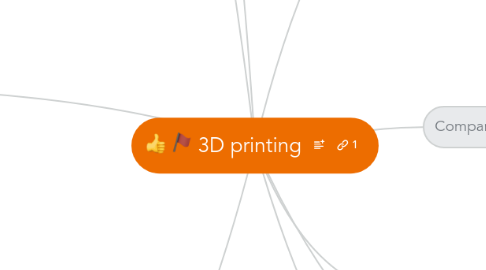
1. A 3D-printedclock was made in 2001
1.1. geers were printed
2. Applications
2.1. Medical use
2.1.1. 3D Bio-printing
2.1.1.1. For Biotechnology firm
2.1.1.1.1. Organ and body tissues /parts can be printed
2.1.2. Chemistry
2.1.2.1. 3D printing medicine
2.2. Construction use
2.2.1. 3D-printed buildings
2.2.1.1. using lunar soil as materials
2.2.1.1.1. Is it possibole?
2.3. Domestic use
2.3.1. 3D printed SLR camera
2.4. Art use
2.4.1. 3D printShow in London (Nov 2013 and 2014)
2.4.1.1. 3D printed plastic and metal
2.4.1.1.1. Interviewed by serveral megazine
2.5. Educational use
2.5.1. Engineering
2.5.2. Architectural planning
2.5.2.1. create a model
2.5.3. Graphic design
2.5.4. Chemistry
2.5.4.1. The relationship of chemistry compounds
2.5.5. Biology
2.5.5.1. Body structure and organs
3. Advantages
3.1. save time in the process of production
3.1.1. especially, when a company is dveloping some new products
3.2. use less energy and materials
3.2.1. less flaws during design
3.3. easy to produce some products with complicated shapes
3.3.1. people no longer need to stay at the stage of imagination
3.4. have better end-products
3.5. greater design flexibility
3.6. fast and effective communication of design ideas
3.7. fast and relatively inexpensive way of trying out a new design
3.7.1. good for promotional videos and usable prototypes for exhibition and promotion
3.8. elimination of storage cost
3.8.1. no longer need to buy large equipments
3.9. boon for organ donation (bioprinting)
3.9.1. for example, by this printing skill, we can produce heart, brain.. these organs .
3.9.2. It helps solve the shortage of donor organs and no longer need to cut down organ rejections
3.10. creation of employment opportunities
3.10.1. due to this skill, more highly-skilled designers are required in the market.
4. Disavantages
4.1. Limitations
4.1.1. only for small-scale use
4.1.2. available materials are limited
4.2. Time consuming to print a 3D model
4.3. customers may have too high expectations on the out coming products
4.4. counterfeiting problem may be serious
4.4.1. easy for people to produce fake products in the market
4.5. concerning issues
4.5.1. people may easily manufacture dangerous items, e.g.guns or other weapons
4.6. production of more unneccessary stuffs
4.7. 3D priniting skill is still not so mature
4.7.1. current materials for investment casting tend to yield sporadically rough surface
4.8. this may not be suitable for large-sized applications
4.9. Costly
4.9.1. High cost for professional 3D software and 3D model design
4.9.2. Cost of 3D printers are high
4.9.3. the cost of this printing skill is still quite expensive
5. Working Process
5.1. 1. Construct a digital 3D-model
5.2. 2. Saved in STL format
5.3. 3. Sent file to a 3D printer
5.4. 4. Print the design layer by layer and form a real object
6. Background Information
6.1. Development
6.1.1. 1984 - Charles Hull developed the technology for printing physical 3D objects from digital data
6.1.2. 1992 - First 3D Printer is Built. The first Stereolithographic Apparatus (SLA) is made by 3D Systems
6.1.3. 1999 - First 3D printed organ. The first ever 3D organ, a bladder, is created with the patient’s own cells. This means that there is little chance of the organ being rejected by the body
6.1.4. 2002 - Working 3D Printed Organs. A miniture kidney is created that can filter blood and produce diluted urine in an animal.
6.1.5. 2006 - SLS Invented and Used for Mass Customisation. The Selective LASER Sintering machine is built and allows for mass customisation in manufacturing industrial parts
6.1.6. 2006 - 3D Printing in Multiple Materials. Objet ( a 3D systems and materials provider) develop a machine that can print in multiple materials
6.1.7. 2008 - First Usable Prosthetic Leg. A prosthetic leg is created with a complex structure that requires no assembly. This opens the doorway to customised prosthetic limbs
6.1.8. 2009 - 3D Printed Blood Vessels. Innovative bioprinting company, Organovo, creates the first blood vessel to be bioprinted
6.1.9. 2011 - Printing Gold and Silver. Printing Service, i.materialise, starts offering 14K gold and STERLING SILVER as a printable material.
6.2. Definition
6.2.1. known as desktop fabrication or additive manufacturing
6.2.2. prototyping process
7. Comparison with 2D printing
7.1. 2-dimensional VS 3-dimensional
7.1.1. Image created on a flat surface VS shaped layers
7.2. Computer-aided design package or 3D scanner
8. Types of technology
8.1. Extrusion
8.1.1. Fused deposition modelling (FDM)
8.2. Wire
8.2.1. Electron Beam Freeform Fabrication (EBF3)
8.3. Granular
8.3.1. Selective laser sintering (SLS)
8.4. Powder bed and inkjet head 3D printing
8.4.1. Plaster-based 3D printing (PP)
8.5. Laminated
8.5.1. Laminated object manufacturing (LOM)
8.6. Light polymerised
8.6.1. Stereolithography (SLA)
